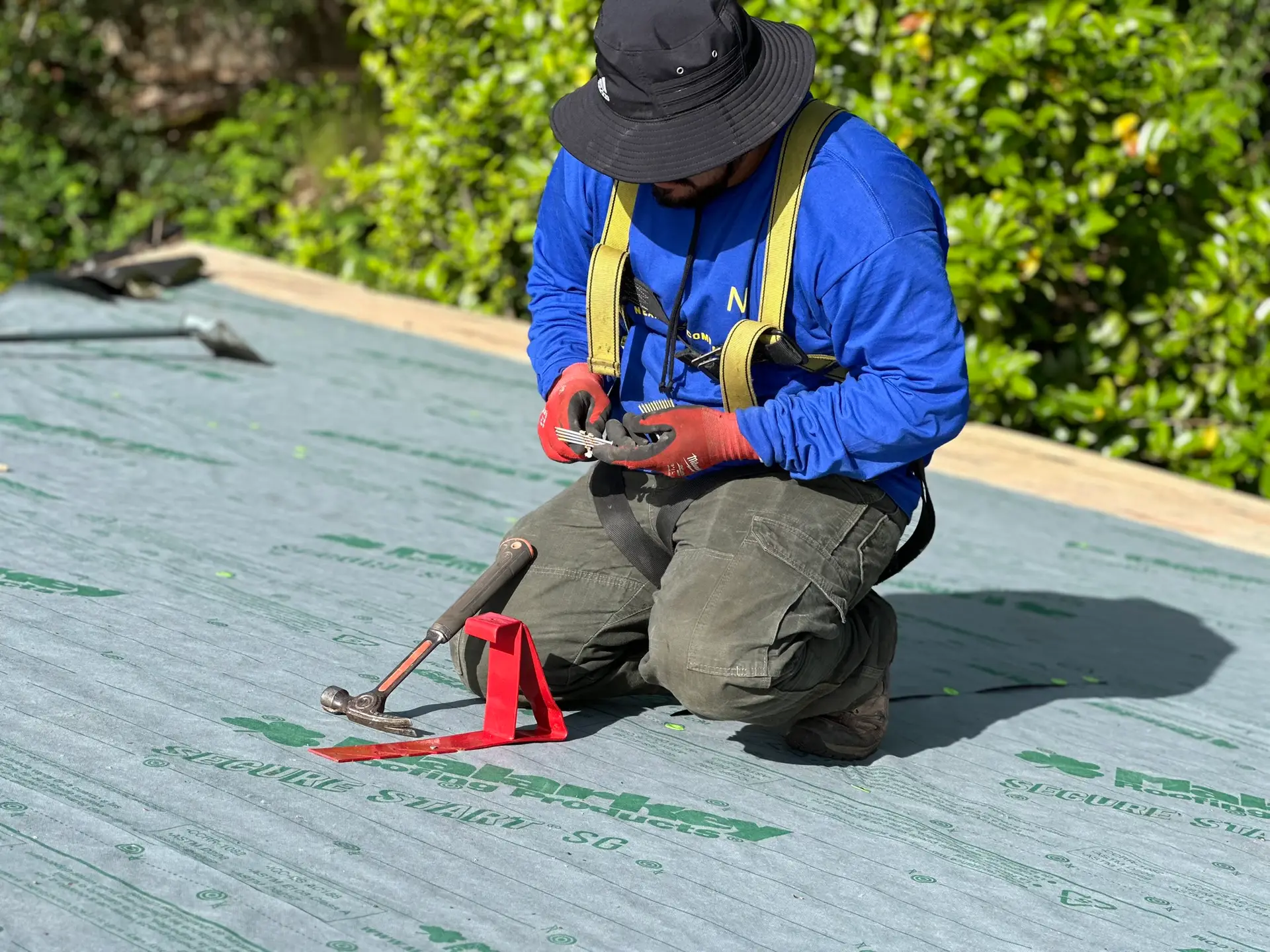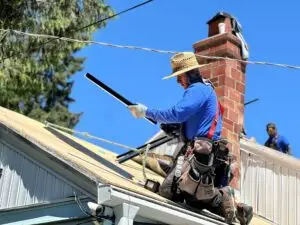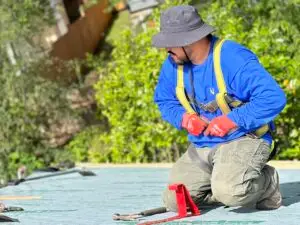Seattle’s rainy season is long and unpredictable. That means that if your roof leaks, you’ll need to take immediate steps to protect your home from water damage until the roofing professionals arrive.
These temporary fixes are simply measures that buy you time, and even the most properly installed fixes only last 2 to 4 weeks in the rainy season. That’s why it’s important to work on getting a permanent solution while using temporary ones to contain the damage and to inspect your roof for damage or potential problems.
In this blog, we’ll explore why leaks occur, what temporary measures you can take to stop the leak, what to do to prevent future leaks, and more.
What Causes Roof Leaks?
Before we look at what interim measures you can take to stop your leaking roof, let’s look at why leaks occur in the first place. Here are some common causes:
- Installation Errors: Most leaks happen because of incorrect installation of the roof’s elements, such as skylights, flashing, and vents. Water can penetrate inside from gaps in these structures and cause damage.
- Aging Materials: Many roofing materials, such as shingles and sealants, lose their effectiveness over time. This may lead to cracks, gaps, rust, and other damage, which makes it easier for water to seep inside.
- Clogged Drainage: When gutters and drainage channels become clogged with leaves, debris, twigs, and even bird droppings, the water may start to pool and affect the integrity of the roof’s waterproofing. Standing water can also back up and find its way inside from under the roof’s edge.
- Structural Shifts: Buildings settle over time, and even a slight shift can cause the sealants to come away from the edges, causing gaps.
Temporary Solutions to Roof Leaks
There are a few steps you can take to minimize the damage while you wait for the experts to arrive and take a look at the leak. Let’s look at a few temporary DIY solutions below:
1. Tarping
Using a heavy-duty waterproof tarp over leaking areas of the roof is one of the most common temporary solutions to leaks. It can be implemented within a few hours and is quite useful in heavy rainfall.
Pick a tarp that’s at least three feet wider than the damaged area in all directions. Make sure it’s stretched taut and overlaps with intact sections of the roof. It should also be sloped to allow water to slide off instead of pooling and putting more weight on the roof’s structure.
If the damaged area is large, use multiple tarps that overlap each other and allow the water to run off. Secure the tarp with nails (using boards to prevent tearing), screws, rubber washers, or any other anchoring method so that water is kept out until permanent repairs are done.
Note that tarps are more durable than plastic sheets, even though plastic is economical and more easily available.
2. Roofing Cement
Roofing cement is an excellent temporary solution for patching up small holes and cracks. Clean the area around the leak to remove any debris or loose material that may prevent proper adhesion, and apply a layer of roofing cement over the affected area to seal it.
Roofing cement is usually available at home improvement retailers in powder form and needs to be mixed with water to form a paste that, upon curing, will form a solid, waterproof barrier.
However, it’s important to note that even though it looks like a permanent solution, roofing cement is just a temporary fix, and you should not rely on it for a prolonged period. This is because roofing cement is rigid and can crack if the house settles. It is also prone to degradation under UV rays and temperature fluctuations.
3. Sealants
Flexible sealants and liquid roof patching products are typically sold in tubes and are made from rubberized compounds that maintain their flexibility even after curing. Some advanced formulations also include fibers to reinforce the sealing properties and resist tearing.
This is especially useful in situations where the house settles or the roof undergoes natural thermal movement, which allows the sealant to expand or contract without cracking or coming away from the sides.
Sealants such as silicone and polyurethane are excellent DIY solutions for waterproofing smaller leaks and are particularly useful when working with roofing materials like asphalt shingles or metal panels.
To apply the sealant, first clean the target area to remove any debris or loose materials that might compromise adhesion. Apply the sealant directly onto the damaged area and allow it to cure according to the manufacturer’s recommendations.
While these flexible sealants outperform rigid materials like roofing cement, they’re still not a substitute for professional repairs.
4. Roofing Tape
Roofing tape is another temporary solution that is used for sealing leaks and cracks. This is used for smaller gaps or punctures and creates a barrier that reduces, if not completely eliminates, water infiltration.
One significant advantage of roofing tape over other temporary fixes is that it can be applied from inside the attic as well, a good option when accessing the outside may not be viable due to weather conditions or other hazards.
Roofing tape also comes in UV-resistant varieties and contains compounds that are activated with pressure or heat. This creates more durable adhesion compared to standard duct tape or packing tape, which deteriorates rapidly when exposed to moisture or UV rays.
To apply roofing tape, make sure the surface is clean and dry. Then, press the tape firmly to the surface to drive out any air bubbles that could allow water infiltration.
5. Flashing Repairs
If the leak was caused by damaged or incorrectly installed flashing, you can use a combination of roofing cement and flashing tape to close the gaps of the worn-out flashing.
To do this, carefully remove any damaged flashing, clean away old sealant to prep the area, and apply a new layer of roofing cement to seal the gap. Then reapply the tape over the cement.
Immediate Steps to Take When You Discover a Roof Leak
When you first notice a leak, take the following steps immediately, even before you make any temporary fixes to the leak.
1. Identify the Source of the Leak
Sometimes, water stains or discoloration on the ceiling are not directly under the point of entry. That’s because water can travel before dripping. Check the attic and crawl space for damp areas, mold, or moisture trails to pinpoint the source of the problem.
You can mark the area with chalk or any other indicator, which becomes helpful not just for your temporary fix but also for professional roofers who may arrive after the area has dried and the water stains are less visible.
Use a flashlight or a hands-free headlamp to check dark areas – you’ll usually find moisture in the form of darkened patches or water trails. Also, check the areas around the roof’s penetrations, such as skylights, vents, chimneys, and flashing.
Understanding the cause of the leak – severe weather, gradual deterioration, or mechanical damage – also helps in determining the urgency of the repairs needed.
2. Contain the Water
Place buckets or containers under the leak – and like we said, this may or may not be the same as the entry point – to catch dripping water. Use any absorbent material, such as towels, to mop up any water that has already collected to prevent further damage to your floor or belongings and to also avoid dangerous slips.
One effective way to divert water is to insert a nail into the hole or crack, which controls the water flow in one direction instead of allowing it to spread across the ceiling. Place a large container under the nail to collect the water.
The timing of the leak also matters. Leaks that occur during rainstorms require different actions than those that occur in dry weather.
3. Protect Your Belongings
Move furniture and other valuable items away from the leak or relocate them to a drier area in your home if the leak is severe.
You can also take photos or make notes of the affected areas, which would prove helpful in insurance claims and for showing to professional contractors if they arrive after the affected area has dried up a bit.
4. Take Safety Precautions
Leaks can lead to electrical hazards and slippery surfaces, so make sure you take the proper precautions when handling the situation, especially if the leak is severe.
Wear non-slip footwear, avoid touching electrical fixtures, and use a stable ladder with a proper angle. Never attempt to make any repairs in adverse weather, such as rain, high winds, or lightning, as these can increase the chances of accidents. Remember: attempting temporary repairs is never worth risking your safety. If you’re in the Seattle and Bellevue area, we generally recommend calling roofing experts near you for emergency roof repairs.
Tips for Preventing Future Leaks
Temporary solutions to roof leaks reduce immediate damage and prevent the leak from causing further issues until a professional comes in for a full repair.
Meanwhile, here are some proactive steps you can take to make sure you don’t have to face a similar situation again:
- Clear gutters and drainage channels to make sure water doesn’t pool on the roof and can flow freely. Clogged gutters cause leaks when water puts pressure against the roof and starts to backflow.
- Regularly inspect your roof to detect problems like loose flashing and damaged sealants early on and before they lead to major leaks.
- Monitor the weather and prepare for upcoming weather changes. If heavy rain is predicted, secure the tarps and roofing tape and apply your fixes beforehand.
- Improve your roof’s ventilation. A well-ventilated attic regulates temperature, reduces condensation, and doesn’t let moisture accumulate. This makes leaks less likely.
- Make sure that your attic space and roof are well-insulated so that no condensation accumulates and causes water damage.
Get Emergency Roof Repair
At NearMe Roofing Company, we understand that roof leaks can be totally unexpected, especially in the Seattle and Greater Puget Sound area. Our team is always on call, delivering prompt roofing repairs with a leak-stop guarantee to protect your home from further harm. We offer emergency roofing fixes at a moment’s notice to ensure your roof is back to its best in no time. Give us a call today!





